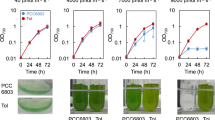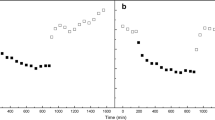Abstract
In this article we describe the partial characterization of a Synechococcus sp. PCC 7942 mutant Mu1 with an enhanced resistance towards the herbicide bentazone (3-isopropyl-1H-2,1,3-benzothiadiazine-4(3H)-one 2,2-dioxide). The mutant was derived from a random mutagenesis with N-methyl-N′-nitro-N-nitrosoguanidine (NSG) and exhibited superior growth rates, pigment content and overall photosynthetic activities under regular growth conditions compared to wild type. Whereas Synechococcus PCC 7942 wild type showed significant photoinhibition, especially in the presence of lincomycin, Mu1 was much more robust. A comparative analysis of the content of several photosynthesis-associated proteins revealed that Mu1 had an increased expression of PsbO on mRNA and protein level and that PsbO is tightly bound to Photosystem II, relative to wild type. This result was substantiated by mass spectrometer measurements of photosynthetic water oxidation revealing a higher stability and integrity of the water oxidizing complex in Mu1 cells grown under regular or calcium deficient conditions. Therefore, our results give rise to the possibility that the overexpression of PsbO in mutant Mu1 confers resistance to reactive oxygen species (ROS) formed as a consequence of bentazone binding to the acceptor side of PS II. In addition, we observed a significantly higher tolerance towards bentazone in iron depleted wild type cells, conditions under which the IdiA protein becomes expressed in highly elevated amounts. As we have previously shown, IdiA preferentially protects the acceptor site of PS II against oxidative stress, especially under iron limitation. Thus, it is likely that IdiA due to its topology interferes with bentazone binding or protects PS II against ROS generated in the presence of bentazone.
Similar content being viewed by others
References
Ajlani G, Meyer I, Vernotte C and Astier C (1989) Mutation in phenol-type herbicide resistance maps within the psbA gene in Synechocystis 6714. FEBS Lett 246: 207–210
Aro EM, Virgin I and Andersson B (1993) Photoinhibition of Photosystem II. Inactivation, protein damage and turnover. Biochim Biophys Acta 1143: 113–134
Asada K (1994) Production and action of active oxygen species in photosynthetic tissues. In: Foyer CH and Mullineaux C (eds) Causes of Photooxidative Stress and Amelioration of Defense Systems in Plants, pp 77–104. CRC Press, Boca Raton, Florida
Asada K (1999) The water-cycle in chloroplasts: scavenging of active oxygens and dissipation of excess photons. Annu Rev Plant Physiol Plant Mol Biol 50: 601–639
Asada K (2000) The water-water cycle as alternative photon and electron sinks. Philos Trans R Soc London B Biol Sci 355: 1419– 1431
Ashton FM and Crafts AS (1981) Mode of Action of Herbicides. Wiley, New York Bader KP (1994) Physiological and evolutionary aspects of the O2/H2O2-cycle in cyanobacteria. Biochim Biophys Acta 1188: 213–219
Bader KP and Schmid GH (1989) Photosynthetic and respiratory oxygen gas exchange measured by mass spectroscopy. Biochim Biophys Acta 974: 303–310
Barber J and Andersson B (1992) Too much of a good thing: light can be bad for photosynthesis. Trends Biochem Sci 17: 61–66
Barry BA, Boerner RJ and de Paula JC (1994) The use of cyanobacteria in the study of the structure and function of Photosystem II. In: Bryant DA (ed) The Molecular Biology of Cyanobacteria, pp 217–257. Kluwer Academic Publishers, Dordrecht, The Netherlands
Burnap RL, Shen JR, Jursinic PA, Inoue Y and Sherman LA (1992) Oxygen yield and thermoluminescence characteristics of a cyanobacterium lacking the manganese-stabilizing protein of Photosystem II. Biochemistry 31: 7404–7410
Dalla Chiesa M, Friso G, Deak Z, Vass I, Barber J and Nixon PJ (1997) Reduced turnover of the D1 polypeptide and photoactivation of electron transfer in novel herbicide resistant mutants of Synechocystis sp. PCC 6803. Eur J Biochem 248: 731–740
Debus RJ (1992) Themanganese and calcium ions of photosynthetic oxygen evolution. Biochim Biophys Acta 1102: 269–352
Engels DH, Engels A and Pistorius EK (1992) Isolation and partial characterization of an L-amino acid oxidase and of Photosystem II complexes from the cyanobacterium Synechococcus PCC 7942. Z Naturforsch [C] 47: 859–866
Engels DH, Lott A, Schmid G and Pistorius EK (1994) Inactiviation of the water-oxidizing enzyme in manganese stabilizing protein-free mutant cells of the cyanobacteria Synechococcus PCC 7942 and Synechocystis PCC 6803 during dark incubation and conditions leading to photoactivation. Photosynth Res 42: 227–244
Exss-Sonne P, Toelle J, Bader KP, Pistorius EK and Michel KP (2000) The IdiA protein of Synechococcus sp. PCC 7942 functions in protecting Photosystem II under oxidative stress. Photosynth Res 63: 145–157
Fedtke C (1982) Biochemistry and Physiology of Herbicide Action. Springer-Verlag, Berlin
Golden SS and Sherman LA (1984) Biochemical and biophysical characterization of herbicide-resistant mutants of the unicellular cyanobacterium, Anacystis nidulans R2. Biochim Biophys Acta 764: 239–246
Grimme LH and Boardman NK (1972) Photochemical activation of a particle fraction P1 obtained from the green alga Chlorella fusca. Biochem Biophys Res Commun 49: 1617–1623
Ke B (2001) The primary electron donor of Photosystem II, P680, and photoinhibition. In: Photosynthesis: Photobiochemistry and Photobiophysics, pp 271–304. Kluwer Academic Publishers, Dordrecht, The Netherlands
Krieger-Liszkay A and Rutherford AW (1998) Influence of herbicide binding on the redox potential of the quinone acceptor in Photosystem II: relevance to photodamage and phytotoxicity. Biochemistry 37: 17339–17344
Laberge D, Rouillon R and Carpentier R (2000) Comparative study of thylakoid membranes sensitivity for herbicide detection after physical or chemical immobilization. Enzyme Microb Technol 26: 332–336
Mallipudi LR and Gleason FK (1989) Characterization of a mutant of Anacystis nidulans R2 resistant to the natural herbicide cyanobacterin. Plant Sci 60: 149–154
Mano J, Takahashi M and Asada K (1987) Oxygen evolution from hydrogen peroxide in Photosystem II: flashed-induced catalytic activity of water-oxidizing Photosystem II membranes. Biochemistry 26: 2495–2501
Mayes SR, Cook KM, Self SJ, Zhang Z and Barber B (1991) Deletion of the gene encoding the Photosystem II 33 kDa protein from Synechocystis sp. PCC 6903 does not inactivate water-splitting but increases vulnerability to photoinhibition. Biochem Biophys Acta 1060: 1–12
Meunier PC, Colon-Lopez MS and Sherman LA (1998) Photosystem II cyclic heterogeneity and photoactivation in the diazotrophic, unicellular cyanobacterium Cyanothece species ATCC 51142. Plant Physiol 116: 1551–1562
Michel KP and Pistorius EK (1992) Isolation of a Photosystem II associated 36 kDa polypeptide and an iron stress 34 kDa polypeptide from thylakoid membranes of the cyanobacterium Synechococcus PCC 6301 grown under mild iron deficiency. Z Naturforsch [C] 47: 867–874
Michel KP, Thole HH and Pistorius EK (1996) IdiA, a 34 kDa protein in the cyanobacteria Synechococcus sp. strains PCC 6301and PCC 7942, is required for growth under iron and manganese limitations. Microbiology 142: 2635–2345
Michel KP, Kruger F, Puhler A and Pistorius EK (1999) Molecular characterization of idiA and adjacent genes in the cyanobacteria Synechococcus sp. strains PCC 6301 and PCC 7942. Microbiology 145: 1473–1484
Mishra NP and Ghanotakis DF (1994) Exposure of a Photosystem II complex to chemically generated singlet oxygen results in D1 fragments similar to the ones observed during aerobic photoinhibition. Biochim Biophys Acta 1187: 296–300
Miyao M (1994) Involvement of active oxygen species in degradation of the D1 protein under strong illumination in isolated subcomplexes of Photosystem II. Biochemistry 33: 9722–9730
Narusaka Y, Narusaka M, Kobayashi H and Satoh K (1998) The herbicide-resistant species of the cyanobacterial D1 protein obtained by thorough and random in vitro mutagenesis. Plant Cell Physiol 39: 620–626
Oettmeier W(1992) Herbicides of Photosystem II. In: Barber J (ed) The Photosystems: Structure, Function and Molecular Biology, pp 349–408. Elsevier Science Publishers, Amsterdam
Oettmeier W (1999) Herbicide resistance and supersensitivity in Photosystem II. Cell Mol Life Sci 55: 1255–1277
Ohad N, Amir-Shapira D, Koike H, Inoue Y, Ohad I and Hirschberg J (1990) Amino acid substitutions in the D1 protein of Photosystem II affect QB-stabilization and accelerate turnover of D1. Z Naturforsch [C] 45: 402–407
Park YI, Sandstrom S, Gustafsson P and Oquist G (1999) Expression of the isiA gene is essential for the survival of the cyanobacterium Synechococcus sp. PCC 7942 by protecting Photosystem II from excess light under iron limitation. Mol Microbiol 32: 123–129
Perewoska I, Etienne AL, Miranda T and Kirilovsky D (1994) S1 destabilization and higher sensitivity to light in metribuzinresistant mutants. Plant Physiol 104: 235–245
Philbrick JB, Diner BA and Zilinskas BA (1991) Construction and characterization of cyanobacterial mutants lacking the manganese-stabilizing polypeptide of Photosystem II. J Biol Chem 266: 13370–13376
Phister K and Arntzen CJ (1979) The mode of action of Photosystem II specific inhibitors in herbicide-resistant weed biotypes. Z Naturforsch [C] 34: 996–1009
Rippka R (1988) Isolation and purification of cyanobacteria. Methods Enzymol 167: 3–27
Rutherford AW and Krieger-Liszkay A (2001) Herbicide-induced oxidative stress in Photosystem II. Trends Biochem Sci 26: 648– 653
Sajjaphan K, Shapir N, Judd AK, Wackett LP and Sadowsky MJ (2002) Novel psbA1 gene from a naturally occurring atrazineresistant cyanobacterial isolate. Appl Environ Microbiol 68: 1358–1366
Sambrook J, Fritsch EF and Maniatis T (1989) Molecular Cloning: a Laboratory Manual. Cold Spring Harbor Laboratory, Cold Spring Harbor, New York
Samuilov VD (1997) Photosynthetic oxygen: the role of H2O2. A review. Biochemistry (Moscow) 62: 451–454
Schaegger H and von Jagow G (1987) Tricine-sodium dodecylsulphate-polyacrylamide gel electrophoresis for the separation of proteins in the range from 1 to 100 kDa. Anal Biochem 166: 368–379
Schroeder WP and Akerlund HE (1986) H2O2 accessibility to the Photosystem II donor side in protein-depleted inside-out thylakoids measured as flash-induced oxygen production. Biochem Biophys Acta 848: 359–363
Seidler A (1996) The extrinsic polypeptides of Photosystem II. Biochim Biophys Acta 1277: 35–60
Sherman LA, Meunier PC and Colon-Lopez MS (1998) Diurnal rhythms in metabolism. A day in the life of a unicellular, diazotrophic cyanobacterium. Photosynth Res 58: 25–42
Shutova T, Irrgang K, Klimov VV and Renger G (2000) Is the manganese stabilizing 33 kDa protein of Photosystem II attaining a 'natively unfolded' or 'molten globule' structure in solution? FEBS Lett 467: 137–140
Smeda RJ, Hasegawa PM, Goldsbrough PB, Singh NK and Weller SC (1993) A serine-to-threonine substitution in the triazine herbicide-binding protein in potato cells results in atrazine resistance without impairing productivity. Plant Physiol 103: 911–917
Smith PK, Krohn RI, Hermanson GT, Mallia AK, Gartner FH, Provencano MD, Fujimoto EK, Goecke NM, Olson BJ and Klenk DC (1985) Measurement of protein using bicinchoninic acid. Anal Biochem 150: 368–379
Stephan DP, Ruppel HG and Pistorius EK (2000) Interrelation between cyanophycin synthesis, L-arginine catabolism and photosynthesis in the cyanobacterium Synechocystis sp. strain PCC 6803. Z Naturforsch [C] 55: 927–942
Trebst A (1987) The three-dimensional structure of the herbicide binding niche on the reaction center polypeptides of Photosystem II. Z Naturforsch [C] 42: 742–750
Tucker DL, Hirsh K, Li H, Boardman B and Sherman LA (2001) The manganese stabilizing protein (MSP) and the control of O2 evolution in the unicellular, diazotrophic cyanobacterium, Cyanothece sp. ATCC 51142. Biochim Biophys Acta 1504: 409–422
Vermaas WJF, Renger G and Arntzen CJ (1983) Herbicide/quinone binding interactions in Photosystem II. Z Naturforsch [C] 39: 368–373
Wydrzynski T, Angström J and Vännegard T (1989) H2O2 formation by Photosystem II. Biochim Biophys Acta 973: 23–28
Author information
Authors and Affiliations
Corresponding author
Rights and permissions
About this article
Cite this article
Bagchi, S.N., Pistorius, E.K. & Michel, KP. A Synechococcus sp. PCC 7942 mutant with a higher tolerance towards bentazone. Photosynthesis Research 75, 171–182 (2003). https://doi.org/10.1023/A:1022836218176
Issue Date:
DOI: https://doi.org/10.1023/A:1022836218176




